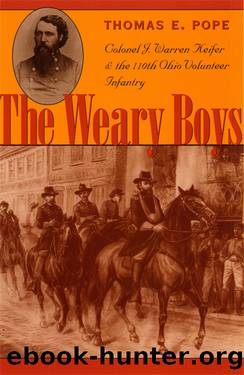The Weary Boys by Thomas E. Pope

Author:Thomas E. Pope [Pope, Thomas E.]
Language: eng
Format: epub
Tags: History, Military, Wars & Conflicts (Other), Technology & Engineering, Military Science
ISBN: 9780873387293
Google: cBcCj7apIVsC
Publisher: Kent State University Press
Published: 2002-01-15T04:10:55+00:00
Pvt. John Free. Courtesy of Larry Strayer.
Sgt. James Howell of Company E fell when a Confederate ball struck and broke his leg. Since he was unable to leave the battlefield, the Rebels captured the wounded man, and doctors amputated his leg. Two days later at Frederick, Sergeant Howell died from his wound. During the fighting on the Union left, Pvt. John Free of Company A was killed. After being shot in the arm, Cpl. Josiah Hill spent the next three weeks in Baltimore and Annapolis hospitals. During the month of August, Hill went home on furlough. On September 2, he returned to the hospitals in Baltimore and Washington. The next month, Hill reported to Harpers Ferry and on November 27 finally returned to active duty.17
General Wallaceâs force suffered 1,294 casualties, primarily soldiers from Rickettsâs command. The First Brigade lost 505 men, while the Second Brigade suffered 567 casualties. The 110th Ohio accounted for 11 percent of the total Federal casualties at Monocacy. The regiment lost 1 officer and 3 enlisted men killed, 5 officers and 77 men wounded, and 2 officers and 50 enlisted men captured or missing, for an aggregate of 138 casualties.18
On July 10, Earlyâs force continued its march east. The next day, these Confederate troops reached the outer fortifications of Washington. As Early approached Fort Stevens on the northwest corner of the capital, the first elements of the Sixth Corps arrived from City Point. Realizing that additional Union reinforcements must be coming, Early retreated to the relative safety of the Shenandoah Valley. The Sixth Corps and the recently arrived Nineteenth Corps pursued the Army of the Valley around the Blue Ridge Mountains and through the many gaps.19
Rickettsâs Third Division arrived in Washington on July 14 and, after marching nearly forty miles in the next three days, finally caught up with the Federal main body at Hamilton, Virginia. On July 20, Maj. Gen. Horatio G. Wrightâs corps began a retrograde movement. Three days later, the Union veterans marched across the Chain Bridge into Washington, D.C.
On July 26, Wrightâs command moved along the northern bank of the Potomac River and three days later crossed the Potomac at Harpers Ferry, camping near Bolivar, West Virginia. The next morning, the Federals again crossed the Potomac. On July 31, they finally encamped for two days near Frederick, Maryland. Wrightâs command crossed the Monocacy River on August 3 and camped near the Third Divisionâs battlefield.20
During this two-week span, the Union troops marched approximately 170 miles. Corporals Rhoades and Hill complained about the extremely difficult conditions. Rhoades, in fact, temporarily became lame when his great-toenails blackened and fell off. On July 28, Private Rosser returned to the 110th Ohio after he escaped from his Confederate captors. During the regimentâs stay near Frederick, several members visited the Monocacy battlefield. In his August 4 letter to the Troy Times, âJoppaâ described the battle and the experiences of several men. One veteran stated that âon top of the hill there when they shelled us, I lay so flat I wasânt thicker than a side of sole leather.
Download
This site does not store any files on its server. We only index and link to content provided by other sites. Please contact the content providers to delete copyright contents if any and email us, we'll remove relevant links or contents immediately.
| United States | Abolition |
| Campaigns & Battlefields | Confederacy |
| Naval Operations | Regimental Histories |
| Women |
In Cold Blood by Truman Capote(3304)
Steve Jobs by Walter Isaacson(2830)
The Innovators: How a Group of Hackers, Geniuses, and Geeks Created the Digital Revolution by Walter Isaacson(2826)
All the President's Men by Carl Bernstein & Bob Woodward(2325)
Lonely Planet New York City by Lonely Planet(2168)
And the Band Played On by Randy Shilts(2127)
The Room Where It Happened by John Bolton;(2100)
The Poisoner's Handbook by Deborah Blum(2089)
The Murder of Marilyn Monroe by Jay Margolis(2055)
The Innovators by Walter Isaacson(2045)
Lincoln by David Herbert Donald(1943)
A Colony in a Nation by Chris Hayes(1880)
Under the Banner of Heaven: A Story of Violent Faith by Jon Krakauer(1743)
Amelia Earhart by Doris L. Rich(1644)
The Unsettlers by Mark Sundeen(1641)
Birdmen by Lawrence Goldstone(1618)
Dirt by Bill Buford(1608)
Being George Washington by Beck Glenn(1605)
Zeitoun by Dave Eggers(1586)
